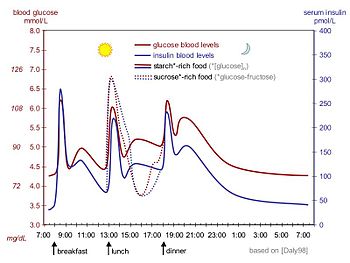 |
| English: idealized curves of human blood glucose and insulin concentrations during the course of a day containing three meals; in addition, effect of sugar-rich meal is highlighted; (Photo credit: Wikipedia) |
Today we review research conducted in Mexico that examined the links between air pollution and insulin sensitivity. Results indicated that short term (under 2 months) exposure to fine particulates (PM2.5) was linked to lower insulin sensitivity and higher cholesterol and this effect was highest with obese patients.
Key Quotes:
“Ambient air pollutant concentrations (NO2, O3, and PM2.5) for short- and long-term periods were assigned by spatial interpolation (maximum interpolation radius of 50 km) of data from air quality monitors. Traffic-related air pollution from freeways (TRAP) was estimated using the dispersion model as NOx”
“Short-term (up to 58 days cumulative lagged averages) exposure to PM2.5 was associated with lower insulin sensitivity and HDL-to-LDL cholesterol ratio and higher fasting glucose and insulin, HOMA-IR, total cholesterol, and LDL cholesterol (LDL-C)”
“The effects of short-term PM2.5 exposure on insulin sensitivity were largest among obese participants.” “Exposure to ambient air pollutants adversely affects glucose tolerance, insulin sensitivity, and blood lipid concentrations.”




No comments:
Post a Comment